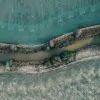Issue topic
Drowning in procedures. About planning in water management
Planning is an integral part of our daily life. Sometimes it is a complex process, and sometimes it involves uncomplicated, targeted activities – shopping, vacations, professional development, etc. Starting from this simple definition – planning is the process of setting goals and appropriate actions to achieve those goals.
How do we plan in water management?
In water management, planning is primarily based on the provisions of the Water Law. The need to develop and publish key planning documents stems precisely from this law. So why do we talk about the complexity of this process? An important factor conditioning the content of the Water Law is the need to implement the provisions of the various EU directives on water into this act. And there are quite a few, given that the law deals with comprehensive water management, but also with a number of aspects in protecting the quantity and quality of water in Poland.
The Water Law and its implementing regulations (ordinances) are more than 800 pages long, making for several volumes the size of an average book. Each of the records brings important considerations for our functioning, of which we are not fully aware. How the fate of this legislation changed we wrote on the occasion of the centenary of its establishment in Poland. Thus, the planning process in water management is complex, multifaceted, intertwining and based on a series of planning and program documents.
The most important planning document
Among the most important planning documents in water management are water management plans (WMPs). The provisions of the Water Law in this regard implement the Water Framework Directive (WFD). PGW in Poland has been in effect since 2011. During those 12 years, it was updated twice, with the second update should go into effect on March 23, 2023.
Why are PGWs so important? These documents include information on, among other things:
- surface, ground, lake, transitional and coastal water bodies;
- Environmental targets set for all of the above. water bodies and water-dependent protected areas;
- deviations from achieving environmental goals;
- primary and complementary activities that should be implemented to achieve environmental goals.
The relevance of PGW’s provisions is not just a matter of awareness of the need to protect water, but determines social and economic functioning in many areas. Whether or not we obtain water rights approval for the planned activity/investment will depend on, among other things. on whether and how our plans will affect the environmental goals set for water bodies. Whether we receive EU funding for our intentions will also have to do with the conditions arising from the PGW – whether our investment will affect environmental goals, and if so, whether it will receive a derogation that will allow implementation under certain conditions. The EU ‘s much-publicized Taxonomy in recent months also conditions the implementation of projects on the principle – do no serious harm to any environmental objective, the so-called “environmental objective”. DNSH (Do No Significant Harm). And where do we find these targets for water? Just in the existing PGW.
The institution responsible for developing the PGW is Wody Polskie.
What else are we planning?
In terms of water planning, the Water Law also includes other important documents – flood risk management plans (FMPs). They are created based on the provisions implemented into our law flood directive. In them we will find the objectives of flood risk management and a catalog of measures to achieve them. We write about how PZRPs are created, what they mean for us, and where we can check if we are at risk of flooding, in this issue of “Water Issues”, in an article titled “Flood Risk Management. “Flooding – what is it and does it threaten me?” As with the PGW, the National Water Service is responsible for developing the PZRP.
Another document containing rules for the protection of surface and groundwater, this time against pollution caused by nitrates of agricultural origin, is the nitrate program, whose full name is “Program of measures to reduce water pollution by nitrates from agricultural sources and prevent further pollution.” The provisions of this program are also backed up by directive guidelines, in this case the so-called “directive”. nitrate directive. The institution responsible for developing and reviewing the nitrate program, published as a Cabinet regulation, is currently the Ministry of Infrastructure. The nitrate program determines a number of activities on farms – from the conditions for storing natural fertilizers, through the timing and doses of nitrogen fertilizer application to reporting on the work carried out. The most important information about the nitrate program can be found in the publications titled “Nitrate Program. “Changes to the Nitrate Program” and “Earlier Spring Fertilization Deadline.”
Returning to the basis for the development of the PGW, the Water Framework Directive, it should be noted that it allows for the emergence of national plans and programs through which its provisions will be implemented more fully. In view of the above, as well as the need to take adaptation measures resulting from climate change, Poland has produced documents such as the Plan for Counteracting the Effects of Drought (PPSS) and the Program for Counteracting Water Scarcity for 2021 – 2027 with an Outlook to 2030 (PPNW). Both documents focus on activities related to increasing retention and drought mitigation.
Do we have a say in water planning?
Public consultations give us opportunities to participate in the process of creating each of the above. planning documents. It is worth remembering that for the largest documents – water management plans and flood risk management plans – they last at least six months. This is really a lot of time to get acquainted with the plans – to find the provisions that interest us, to participate in consultation meetings or to convey our concerns in writing to the institution responsible for developing the document. Water matters, and your vote counts. Let’s not let ourselves drown in procedures.

 Polski
Polski







